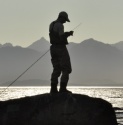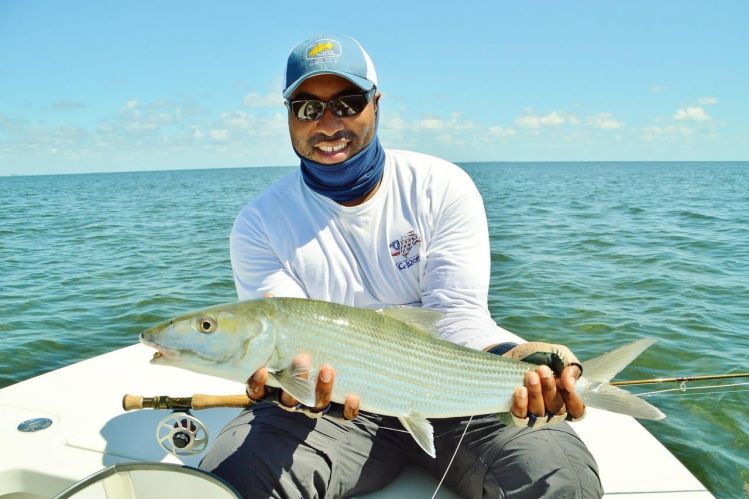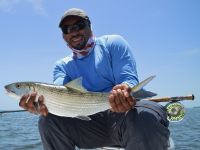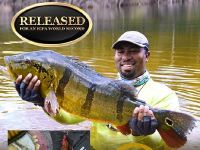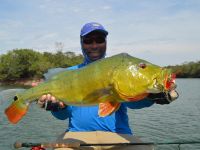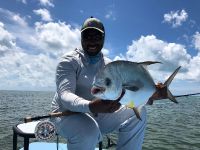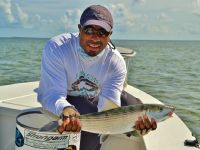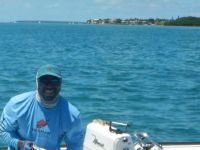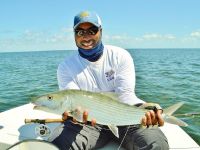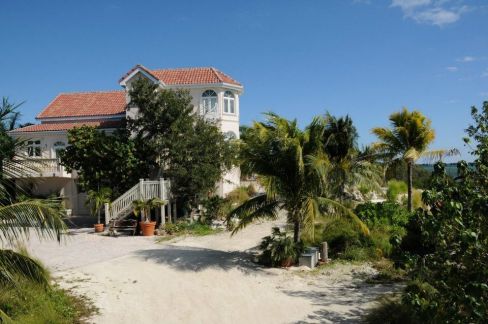Fd: Can you tell us how you became a fly-fishing guide?
The main reason that made me become a flyfishing guide was my passion for the sport. Back when I wasn’t guiding, I would always try to spend as much time on the water as possible, fishing different bodies of water through the keys and the Everglades. It became therapy, a routine, a challenge and a necessity. I was never satisfied with my time on the water and always wanted more. the more I explored and learned, the more I wanted to be out fishing, even though I was out religiously not less than 2-3 times a week.
I found becoming a flyfishing guide the best “excuse” for me to spend more time out on the water doing what I love and making a living out of it. Shortly after I picked up my first clients, I realized that I had the necessary patience and willingness to teach and interact with people so I never looked back. To this day, whenever I’m not guiding anglers, I’m out there fun fishing with my friends and fellow guides. I love it.
Fd: Can you explain to everybody why the areas you fish in are considered great for fly fishing?
very few places in the world, if any, offer the variety of species and ecosystems that south Florida and the keys offer for Flyfishing and light tackle. Being able to access the Everglades National Park to the west and the Atlantic Ocean to the east, creates a myriad of opportunities, and the possibility of accessing different areas and catching different fish species in one day. The fishing areas are so vast that in the Everglades, you can even access bodies of freshwater from the salt and catch largemouth bass after catching tarpon, redfish, sea trout, snook and even bonefish and permit among other important sport fish. You can also access the reef within a 30 minutes ride from the islands and catch sailfish, tuna, kingfish, swordfish, dolphin, snappers among others. I don’t know any other place in the world that offers that mixture. While in Miami, you can be catching bonefish, tarpon, barracuda, sharks, snappers and permit within sight of Downtown Miami’s high rises and luxury buildings.
In addition to the fishing opportunities, you can also find the best accommodations, lodging, local amenities, attractions, night life and in my opinion, the best flats and flyfishing guides anywhere, with the best equipment available.
Fd: What are the best periods to fish with you according to each target species?
Tarpon (April, May and June) is my favorite because we are almost strictly flyfishing for tarpon everyday and it is also the time that provides more income for guides in the keys. With that being said, I gotta say that the very best time of the year to fish in south Florida and the keys is the summer. Calm hot weather and light winds create ideal conditions for almost all the species we target on the flats. Grand and super slams are common in the summer as all the glamour species such as Tarpon, bonefish, permit, snook, redfish and trout are active and readily available.
The fishing in the Everglades during the fall and winter for redfish, snook, tarpon, blackdrum, tripletail and trout is also excellent.
We really have year round fishing in south Florida.
Fd: How would you explain the thrill of catching tarpon?
Tarpon is the sport fish by excellence: they’re big, good looking, acrobatic, put up a long and strong fight, eat a variety of baits, eat small flies and can be caught in shallow-clear water. They can either be very easy to catch or very difficult and technical to make it interesting. They are the perfect package. When you see one of those animals open their mouth, eat the fly and take off putting holes in the water and emptying your reel, is like a drug. You can’t wait until you hook the next one.
Tarpon, like I said before, can be very easy or quite difficult. Juvenile and mid size tarpon in the summer time can be easy to catch but big migratory tarpon in clear water can be very technical and demanding. We don’t do much dredging and blind casting like other destinations. The fishing in the keys is highly visual and we sightfish about 90% of the time. Once again, my fishery offers quality vs quantity.
Fd: What are the average catches a client can expect? And what are the best fish you have seen there?
The catch ratio while Flyfishing in the keys depends on the targeted species and the level of the fisherman. Bonefish and permit can be very technical in the keys and demand casting ability. I would say that it is an intermediate to advance level deal. It is not a numbers game like other destinations. The fishing in the keys offer quality vs quantity. You won’t catch all the numbers that you will in Mexico, Belize or some parts in the Bahamas and the Caribbean but our bones are some of the biggest in the world. The same applies to permit and tarpon. Catch a couple quality fish and you’ve had a good day. That without saying that we can have days of numbers.
Fd: What kind of fly-fishing gear should anglers take for this trip?
In south Florida and the keys we mostly use 7 through 10wt outfits with floating lines. Rods are mainly fast action and reels need to have a quality drag and be able to hold at least 200 yards of backing.
11 and 12wt outfits are only used for big tarpon and sharks. Every professional guide in the keys offers top of the line fly tackle and flies for charters so you don’t have to worry about it and travel light.
Fd: How is the programme for a typical fly-fishing day?
You usually set up a meeting location and time with your guide a couple of days before the charter. Some guides only fish out of one particular marina while others are mobile and trailer to wherever they feel the fishing is gonna be best during any given season or day. I belong to the second group. Be ready to travel and meet your guide in order to access the best fishing areas. That travel time can be anywhere from 15 minutes to 1 hour 30 minutes depending on where you are staying. Most clients rent a car, specially those booking several days. Our typical day is 8 hours of fishing (full day) we also offer quarter day (6 hours) and half day (4 hours).
Fd: What are the lodging options in the area?
Our lodging choices in south Florida and the keys are endless, from AIRB&B to the most well known hotel chains in the world. Your choice and your budget.
Fd: How long before should anglers contact you for reservations?
10-For tarpon season, clients need to set up a guide with no less than 4 months in advance or even more. The spring is the busiest time of the year for Flyfishing guides and most are booked up to a year in advance by long time repeating clients booking several days at once. That’s the reason why we get so busy way ahead of time. Late fall and winter are also quite busy in the keys. You should be fine lining up a guide in the keys one month in advance or less anytime, except for tarpon season.
Fd: Why do you think every angler should fly fish this destination at least once in his life?
The sport of flyfishing in the salt was born in the keys. Most of the flyfishing pioneers of the sport are directly associated with the keys and all the history that surrounds them. The keys are the Mecca of saltwater flyfishing and should be in the bucket list of every fly fisherman.
Fd: What about your peacock bass trips?
I’ve been putting jungle fishing trips together to my natal Colombia for the past 9 years now. I was born there and still have lots of ties to the country. Even though I grew up in the US, I was always connected with Colombia and knew about the enormous potential for fishing and ecotourism it had.
It is also important to remark that Colombia is The Godfather of peacock bass fishing as the first jungle fishing operations in South America were born there in the early 70s, way before the jungle fishery in Brazil was developed and known internationally.
It wasn’t until things got safe there and the armed conflict took a 360 degree change that I decided to start taking a couple trips down to the jungle to start exploring all the fishing opportunities.
After some amazing trips with Colombian friends I realized that this country had crazy potential to become a solid international fishing destination for peacock bass, Payara and other renowned sport fish. Colombia holds absolutely amazing fishing for trophy peacock bass and Payara with lots of IGFA records already to its credit.
There are still several bodies of virgin water there that have never seen any pressure from sport fishing.
The saltwater fishing opportunities in Colombia are also some of the best in the world, being located at one of the richest areas in the pacific for Billfishing, pelagics and inshore fishing.
The dry Jungle fishing season in Colombia runs from January to late March. It can get good as early as November and last as late as May but the prime months are January, February and March. Those are the months that offer ideal water levels for fishing.
It is a very short season and weeks get booked up fast. For proper planning and availability, people usually book these trips with a minimum of 6 months ahead of time. You can stay tuned about my jungle trips following my social media platforms on IG and FB under @orinocoangling.
You can find more info and contact Alex Zapata, right here: Travel.

